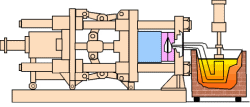Hot Chamber Zinc Castings. The die casting process has become widely popular over the decades. Since a patent was granted to Sturges in 1849, the die casting process has gained patronage from all parts of the industrialized world. Today, there are hundreds upon hundreds of companies that manufacture and sell die cast parts, which are also referred to collectively as die cast tooling. Die cast parts, as known by many, can be created using different materials. The first ones introduced were tin and lead, but the birth of zinc die cast parts in 1914 saw the beginning of a new era in the die casting community. Although copper and aluminum soon followed, zinc and its alloys, whether for hot chamber zinc castings or cold chamber zinc castings, were and still are the favorite die casting materials.
The die casting process in its most basic state consists of injection molten metal into a die (a steel mold) under high pressure. Die casting machines come in various sizes; they are usually rated in clamping tons which are the equivalent of the amount of pressure they will be able to exert on the die or steel mold. But whether a machine is sized at 400 tons or 4,000 tons, the main difference lies in the method employed for the injection of the molten metal into the die casting tool or steel mold. There are two methods available, namely the hot chamber method and the cold chamber method. As far as the zinc die casting process is concerned, hot chamber zinc castings are more popular than cold chamber zinc castings. Hot chamber zinc castings can be produced in less than one second to over two or three minutes, depending on their weight.


